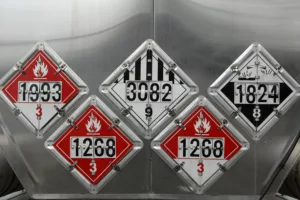
Currently, hazmat shipments account for 12% of all freight shipped within the United States which is roughly 3.3 billion tons of hazardous materials shipped yearly.1 This number has been steadily increasing for years, so it’s more important than ever to collect accurate data about the hazmat shipments in your community.
Federal, state and local agencies often use commodity flow surveys (CFS) to assess transportation trends and identify safety risks or environmental concerns. Leveraging the latest hazmat placard recognition technology, this process is now easier than ever with automated survey solutions. Let’s explore the four key reasons why you should automate your commodity flow surveys.
1. Reduces Data Gaps and Mistakes
Today, most agencies conduct their CFS via manual tracking. This might mean hiring additional labor for a few weeks to manually survey roadway traffic. That data then needs to be manually reported which can often leave gaps in data. Automated systems allow continuous, accurate data collection. Our portable commodity flow solution enables near real-time data collection, reporting the types and quantities of hazardous materials in a user-friendly dashboard. This immediacy allows for prompt decision-making and response, which is vital in transportation environments where conditions can change rapidly.
2. Improved Data Accuracy
Automating your CFS offers a comprehensive picture of hazardous material flow, going beyond manual survey sample sizes. Perceptics’ commodity flow solution utilizes high-quality cameras to capture clear images of vehicles. Once images have been captured, photos are filtered through our Summitt Hazmat software to precisely report hazmat data including symbols, UN number and DOT class numbers. This accuracy is crucial for maintaining reliable records and reporting, which are essential for regulatory compliance and operational transparency. 
3. Enhanced Safety and Preparedness
Continuous hazmat monitoring and more accurate data help improve risk mitigation efforts. Data-backed risk mitigation plans can reduce the likelihood of accidents and minimize environmental impacts by addressing potential risks before they escalate.
Emergency response teams may also benefit from this accurate, real-time data. With better data at their disposal, responders can prepare more effectively and manage hazardous material incidents with greater confidence and efficiency.
4. Flexible, Affordable & Efficient
Typical commodity flow surveys can often be time-consuming and labor-intensive. By ditching manual tracking, you can eliminate the need to for additional workforce to monitor traffic. This not only saves time and labor costs but also frees up personnel to focus on more critical tasks. These portable systems can be used year after year, removing limitations on when you can conduct your CFS. Need to track on smaller, less accessible roads or railways? The portability makes it easy to track wherever you need.
Once you’ve situated your device, the wireless connectivity allows continued monitoring from the comfort of your office.
Looking Ahead
Data-backed policies open the door to a safer tomorrow. With significant hazmat incidents recently making headlines, states and municipalities have the chance to make an impact by committing to more frequent and consistent commodity flow surveys. Automated systems make it easier than ever to collect hazmat data and draft informed response and mitigation plans. With proper coordination and training, emergency responders can also use hazmat data to further enhance their preparedness and effectiveness in crises. Leveraging new technology and policy changes can pave the way to a safer, more efficient, and more resilient future.
Learn more about how our solution can enhance your hazardous material transportation monitoring here.

- PHMSA’s Quarterly Newsletter for Hazardous Materials Safety April-June 2022



